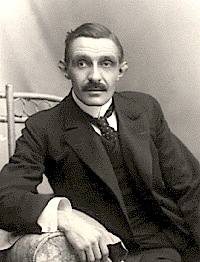Herman Bang facts for kids
Quick facts for kids
Herman Bang
|
|
|---|---|
 |
|
| Born | 20 April 1857 Asserballe, Schleswig |
| Died | 29 January 1912 (aged 54) Ogden, Utah |
| Resting place | Vestre Cemetery (Copenhagen) |
| Occupation | Writer |
| Nationality | Danish |
Herman Joachim Bang (born April 20, 1857 – died January 29, 1912) was a famous Danish journalist and author. He was an important writer during a time of new ideas in Scandinavian literature.
Contents
About Herman Bang
Herman Bang was born in Asserballe, on the small Danish island of Als. His father was a vicar, which is a type of priest.
When he was twenty years old, Herman Bang published two books of essays. These essays looked closely at a new style of writing called realism. In 1880, he released his novel Haabløse Slægter (which means Families Without Hope). This book quickly got a lot of attention. It even caused a stir and was banned for a short time because of its themes.
After traveling and giving successful talks in Norway and Sweden, he settled in Copenhagen. There, he wrote many novels and collections of short stories. These works made him one of the top writers in Scandinavia. Some of his well-known stories include "Fædra" (from 1883) and "Tine" ("Tina", from 1889).
His story "Tine" was especially popular. It earned him the friendship of famous writers like Henrik Ibsen and Jonas Lie. Other important works by Bang include Det hvide Hus (The White House, 1898), Excentriske Noveller (Eccentric Stories, 1885), Stille Eksistenser (Quiet Existences, 1886), Liv og Død (Life and Death, 1899), and Englen Michael (The Angel Michael, 1902). He also wrote a book of poems in 1889 and his memories in Ti Aar (Ten Years, 1891).
His Work and Style
Herman Bang was very interested in what he called "quiet existences." These were the people who often felt overlooked or ignored, living seemingly ordinary lives. He especially liked to write about women who felt lonely or isolated.
For example, his novel Ved Vejen (Katinka, 1886) tells the story of a young wife of a stationmaster. She lives in a difficult marriage and has a secret, unfulfilled passion. Tine (1889) is set during the war with Prussia in 1864 (the Second War of Schleswig). It shares a sad love story about a young girl on the island of Als.
In Stuk (Stucco, 1887), Bang describes a young man's love affair that slowly fades away. This story takes place in Copenhagen during a time of quick changes and economic growth. Another book, Ludvigsbakke (1896), is about a young nurse. She gives her love to a childhood friend who eventually leaves her to marry a rich woman and save his family's property.
Journalism and Theatre
Herman Bang was also a very busy journalist. He wrote for newspapers in Denmark, other Nordic countries, and Germany. He helped develop modern ways of reporting news. His article about the fire at Christiansborg Palace is considered a very important piece of Danish journalism.
Even though he didn't succeed as an actor, Bang became famous as a theatre producer. He worked in Paris and Copenhagen, helping to create many plays.
Later Life and Legacy
Some of Herman Bang's books, like Tina and Katinka, have been translated into many languages. They have also been made into films. His 1902 novel Mikaël was especially popular for silent films. It was made into two movies: The Wings in 1916, directed by Mauritz Stiller, and Michael in 1924, directed by Carl Theodor Dreyer.
Bang's writing style made him known as a leading European impressionist writer. This means he focused on showing feelings and impressions rather than just facts. In his later years, he faced challenges and his health declined. He traveled a lot in Europe. During a trip to the United States for a lecture tour, he became ill on a train and passed away in Ogden, Utah.
Images for kids
See also
 In Spanish: Herman Bang para niños
In Spanish: Herman Bang para niños


